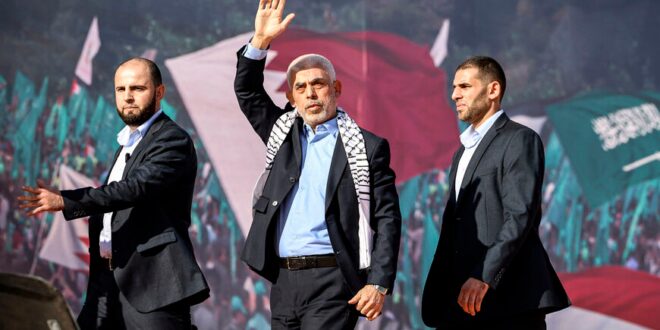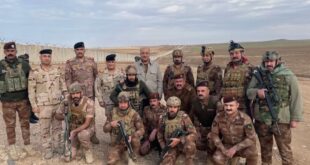Hamas’ Oct. 7 attack seems to have been planned with specific goals in mind, yet without considering the wider consequences for the movement.
A pattern is emerging in Hamas’ behavior where its short-term plans produce unexpected achievements and consequences that supersede the movement’s political capacity to deal with them. The Oct. 7 military surprise against the most powerful army in the Middle East is the most recent manifestation of such a pattern.
Prior to that, two major turning points set in line which fit with this pattern: the movement’s victory in the Palestinian Legislative Council in 2006, and its military takeover of the Gaza Strip in 2007. In all three instances, Hamas’ plans were tactical with intentions to achieve specific objectives, yet the outcome of each turned out to be far-reaching and beyond the movement’s expectations as well as those of other concerned parties.
A reminder of some context of previous incidents helps to see some parallels with the current situation, where unexpected “victories” lead to unintentional consequences, and unpicked opportunities.
The 2006 experiment
In 2006, Hamas ran for election to achieve two main objectives. The first was to strategically circumvent the targeting of the movement by the so-called “war on terror” campaign led by former US President George W. Bush. This campaign began with the direct invasion of Afghanistan after the September 11 attacks, followed by the invasion of Iraq in 2003. It expanded to include a list of countries and organizations that the United States (and Israel) would pursue, including Hamas. In those times, the Palestinian Authority, under American and Israeli pressure, declared that it would join the American war on terror, potentially sparking further conflict between the PA and Hamas.
Simultaneously, and to legitimize America’s wars in the region and globally, Bush launched what was known as the Middle East Partnership Initiative with the claim of democratizing the region, stressing that the war on terror was part of a bigger project that aimed to bring democracy to Arab countries. Within this context, Hamas’ participation in the Palestinian elections intended to protect the movement from the looming crackdown and present itself as a democratic political entity integrated within the Palestinian system, and as such would undermine its terrorist designation and be grouped with other extremist organizations. Hamas, a designated terrorist group iby the United States, used the “campaign to promote democracy” as a way to dodge the other campaign on terror.
Hamas knew then it would secure a strong position in the Palestinian legislature even if its powers were compromised. That would allow it to influence Palestinian decision-making by gaining a significant number of seats, yet at the same time remaining away from the burden of the executive authority that functions in accordance with the Oslo Accords. However, against its initial plans, Hamas won the elections and found itself in an undesirable position: a resistance force rose to become the ruling party of the PA that operates within the framework of the Oslo Accords signed in 1994 by the PLO that Hamas opposes. Hamas did not plan to win and was not prepared to deal with the political consequences of its victory. The regional and international context was, to say the least, not receptive to its new political victory.
Trying to gain regional and international acceptance, the Hamas government issued a manifesto accepting a Palestinian state on the 1967 borders without, however, changing its charter. That gesture fell on deaf ears, and the outside context remained not receptive to Hamas’ new political victory and reality.
The Gaza takeover in 2007
The military takeover of the entire Gaza Strip in 2007 was also unplanned in the way that it eventually manifested. In my research, people close to Hamas told me in 2009 and in 2012 that the immediate and short-term objective was to “punish the Preventative Security Apparatus” of the PA that strived to undermine Hamas’ government and its security control in the Gaza Strip after Hamas won the elections. Once Hamas assumed power, it found itself toothless as the Palestinian security forces remained under the control of President Mahmoud Abbas, effectively creating a two-headed power structure. American efforts at the time supported some security leaders of the Palestinian Authority to weaken Hamas’ government with the aim of showing the movement as incapable at governance. Hamas decided to strike preemptively and hit the PA security force that caused most of the trouble. Its swift success in doing so and the lack of efficiency of the security forces under Abbas’ control tempted Hamas fighters to expand their operation across the entirety of the Strip, ending up with the dismissal of all security forces and the imposition of their military control instead.
Once again, the scale of the surprising “achievement” was unplanned and Hamas was not ready for the consequences. The rest of the story is well known, as it was marked by bitter internal Palestinian division with Hamas controlling the Gaza Strip while the PA under Abbas retained control over the West Bank. In what followed, Hamas found itself the de facto ruler of a besieged Gaza Strip, responsible for delivering services and governance to its 2 million Palestinians.
To its credit however, the movement managed to create an effective governance that was lacking in the Strip in the years 2005 and 2006 after Israel withdrew its troops, due to inefficient and multiple security forces, and the emergence of other groups that made the lives of Gazans unsafe. In the subsequent years and despite the bitterness of the division between Hamas in the Gaza Strip and the PA in the West Bank, there were several chances to reconcile the Palestinian house, then create a national government that could speak to Israel in one voice. Yet, such a reunification was vetoed by Israel and the US, making any move in that direction problematic for the financial support that the PA receives from Washington and in tax revenues from the Israelis. Thus, the regional and international context was, again, unreceptive. Hamas’ achievement turned into a sour reality, as the perpetuation of a split effectively served — and was fed by — Israel.
Similar pattern with Oct. 7
Hamas’ Oct. 7 strike and its military success infiltrating Israeli territory, taking over 200 hostages, and inflicting the deadliest attack on Israel in its recent history, seem to fit this pattern. The immediate question of what motivated Hamas to carry out an operation of such magnitude led many observers to believe it was part of a larger regional plan involving Iran, Hezbollah and the resistance factions. The quick and astonishing success of the operation fueled these initial speculations, suggesting that it was a first phase that would be followed by subsequent phases of the plan executed by external Hamas allies. However, the lack of such anticipated phases coupled with Iran’s and Hezbollah’s denial of operational involvement — so far, at least — attests to the analysis that the strike was anything other than a purely Palestinian initiative, unplanned in cooperation with any other party. Even Hamas leadership outside of Palestine was unaware of it and was surprised just like everyone else. Hamas’ regional allies, Iran and Hezbollah, did not respond “seriously” to the subsequent Israeli onslaught and remained almost bystanders. Hezbollah border skirmishes in the north of Israel remained limited to face-saving, small-scale engagement.
If this was the case, then what was Hamas’ original plan? A definitive answer could be elusive, but one can start with the name Hamas gave to its operation: Al-Aqsa Flood and the Prisoners. This points at two intended objectives: to show support and action to Al-Aqsa and send a message to Israel that continued violations on the Haram al-Sharif would result in strikes by Palestinian resistance, and to capture Israeli soldiers to exchange them for more than 6,000 Palestinian prisoners held in Israeli jails. What happened on the ground surprised Hamas itself, given the ease of the infiltration into Israeli military posts and the apparent Israeli military incompetence on the other side of the border. This tempted Hamas fighters on the ground to continue their advance and expand their territorial and target scope, as confirmed by senior Hamas leader Saleh al-Arouri in an Oct. 12 interview with Al Jazeera. Winning a great victory against Israel was so irresistible and overwhelming, it seemed, that considering the political costs and potential repercussions was absent.
During the extended hours of the operation, Arouri claimed that “civilians from Gaza” entered nearby Israeli towns in a chaotic and uncontrolled manner, conducting acts that were not approved by the movement. He distanced Hamas from all acts that fed the ensuing campaign against his organization. However, the result was a temporal and military triumph that succeeded expectations but proved to be too much to handle. Similar to the previous two successes in 2006 and 2007, Hamas achieved unexpected success that it was unprepared for and couldn’t handle, and where regional and international contexts lined up against the movement.
Hamas latest political move in offering a “comprehensive outlook” for a political solution as stated by Ismail Haniyeh last week on Al-Jazeera, could be seen as an opportunity that turns the current tragedy into an entry point to broader political solutions. But it’s as likely that it will be ignored, as the prospects for more confrontation and retribution rise.
 Eurasia Press & News
Eurasia Press & News



